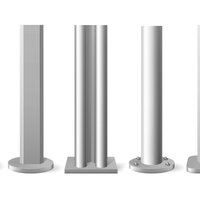
What is the difference between aluminum light poles and steel light poles?
When searching for the right light pole for your site, industrial location, or outdoor lighting, you often come across the choice between aluminum and steel light poles. Both materials offer solid and reliable solutions, but they have their own advantages and disadvantages. In this blog, we'll take a closer look at the difference between aluminum and steel lamp posts so you can make an informed choice for your lighting needs.The Basics: What's the Difference Between Aluminum and Steel?
Aluminum and steel are both popular materials for lighting columns, but they differ in composition, weight, durability and cost. Aluminum is a lightweight metal known for its corrosion resistance, while steel is stronger and often a heavier material. Both have their own specific applications, depending on the requirements of the project.Advantages of Aluminum Light Poles
- Lower Weight: Aluminum light poles are significantly lighter than steel light poles. This makes them easier to transport and install. If you're dealing with hard-to-reach areas or need to install light poles quickly, the low weight of aluminum can be a big advantage.
- Corrosion resistance: Aluminum is naturally corrosion resistant, which means it is less likely to be affected by weather, salt water or other corrosive elements. This makes aluminum light poles an excellent choice for coastal areas or other environments where they are exposed to harsh weather conditions.
- Less maintenance: Because aluminum lamp posts are less prone to rust and corrosion, maintenance is often easier and less frequent. This can save costs in the long run and extend the life of the pole.
- Aesthetically pleasing: Aluminum has a sleeker, more modern appearance than steel, which often makes it a better choice for urban or design-oriented applications, where the appearance of the light pole plays an important role.
Benefits of Steel Lighting Poles
- Strength and Stability: Steel is significantly stronger than aluminum, making it a better choice for situations where the pole must support heavy loads, such as large lighting installations or poles that must also support other equipment such as cameras or signage. Steel lighting poles offer additional stability, especially in areas with strong winds or adverse environments.
- Cost advantage: In general, steel is a less expensive material than aluminum, especially for larger light poles. So if budget is an important factor, steel can be an attractive option. Steel lamp posts often offer good value for money, especially if strength and stability are more important than weight.
- Longer life: with appropriate treatments Steel light poles, with the right finish and protection against rust (such as electroplating or powder coating), can have a long life, even in harsh environments. Properly maintained steel poles can last decades without deteriorating.
- Wider applications: in heavy industry Steel is often used in industrial and heavy-duty applications where lighting must perform under extreme conditions. This makes steel light poles ideal for factories, port areas or other industrial sites, for example.
Comparison of Aluminium and Steel Lampposts
| Feature | Aluminium lamppost | Steel Lamppost |
| Weight | Lightweight and easy to install | Heavier and more robust |
| Corrosion resistance | Very good - Anodized aluminum | Good - Hot dip galvanized |
| Pricing | More expensive compared to steel | More cost-effective than aluminum |
| Lifespan | Over 50 years | Over 30 years |
| Appearance | Modern design | Robust and industrial design |
| Applications | Coastal areas, cities, parks, parking lots, etc. | Business parks, cities, parks, parking lots, etc. |
When Do You Choose Aluminum Light Poles?
Coastal areas or corrosive environments: If you want to install light poles in an environment where they will be exposed to salt water, high humidity or other corrosive elements, aluminum is the better choice.Lightweight and flexible applications: If you are dealing with temporary installations or locations where the poles need to be moved easily, aluminum is ideal because of its lower weight.
Aesthetics and design: For urban environments or locations where the appearance of the pole is important, aluminum often offers a sleeker, more modern design.
When Do You Choose Steel Lighting Columns?
Heavy industry or industrial applications: Steel light poles are the right choice for heavy-duty applications, such as in factories, ports or other industrial sites, where stability and strength are key.Cost-conscious projects: If you need a larger number of light poles and budget is an important factor, steel is often a more cost-effective choice.
Wind-sensitive environments: Steel poles offer additional strength and stability, making them suitable for areas with strong winds or other extreme weather conditions.
Conclusion
Choosing between an aluminum and steel lamp post depends on the specific needs of your project. If you are looking for a lightweight, corrosion-resistant and low-maintenance solution, aluminum is the best choice. However, if you prioritize strength, stability and a lower budget, steel offers excellent performance for heavy industrial applications.Both materials have their place in the world of outdoor lighting. It's important to carefully consider your needs, environment and budget before choosing the right lighting pole.
Need advice? Contact us or view our range of Complete Lighting Columns for immediate use.